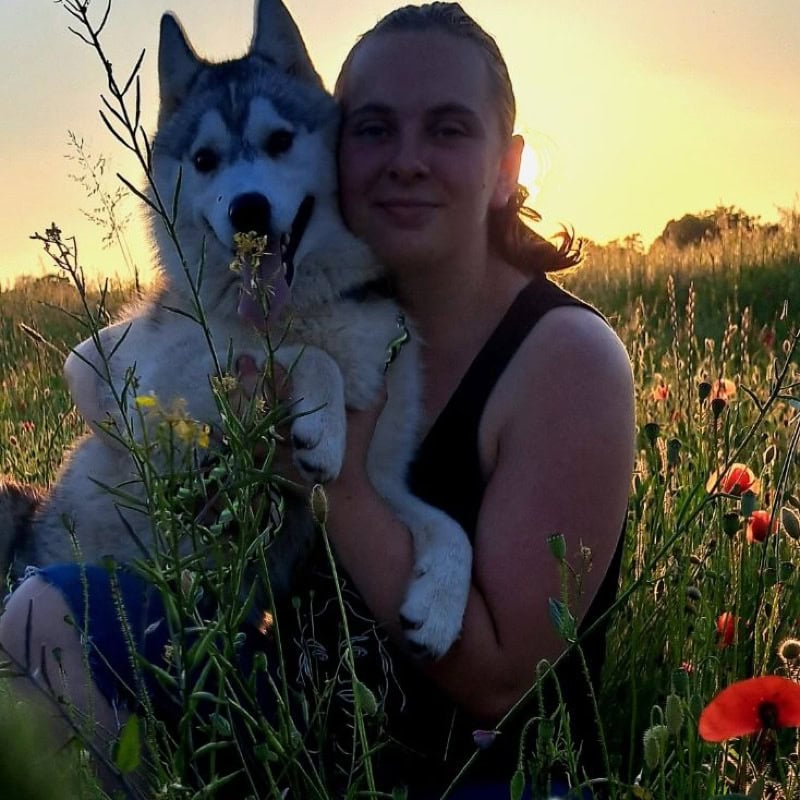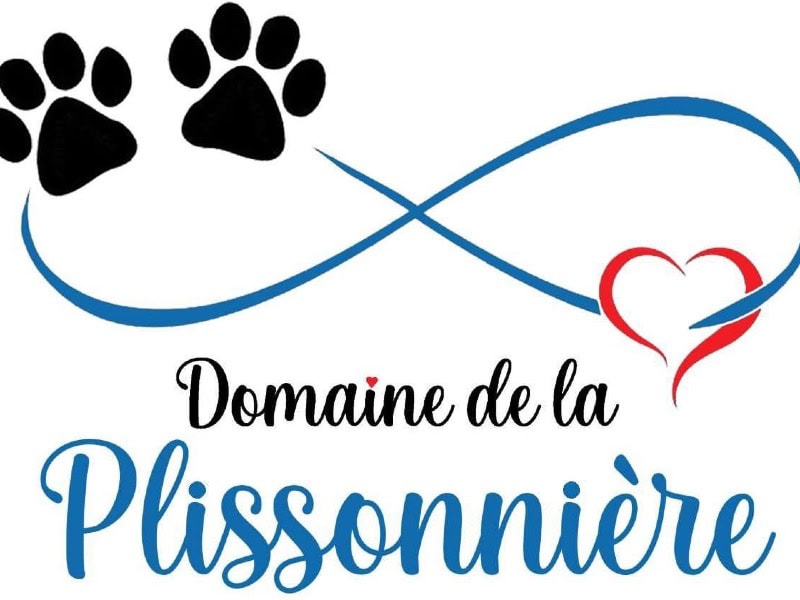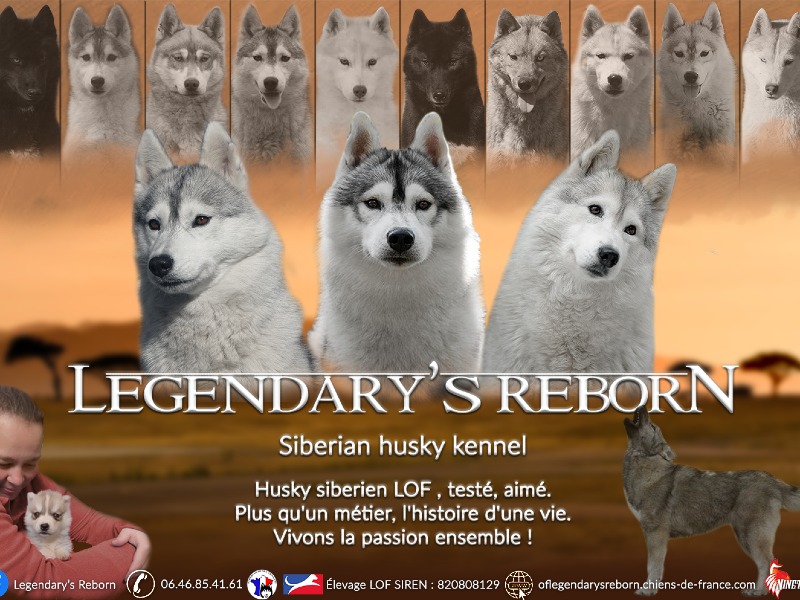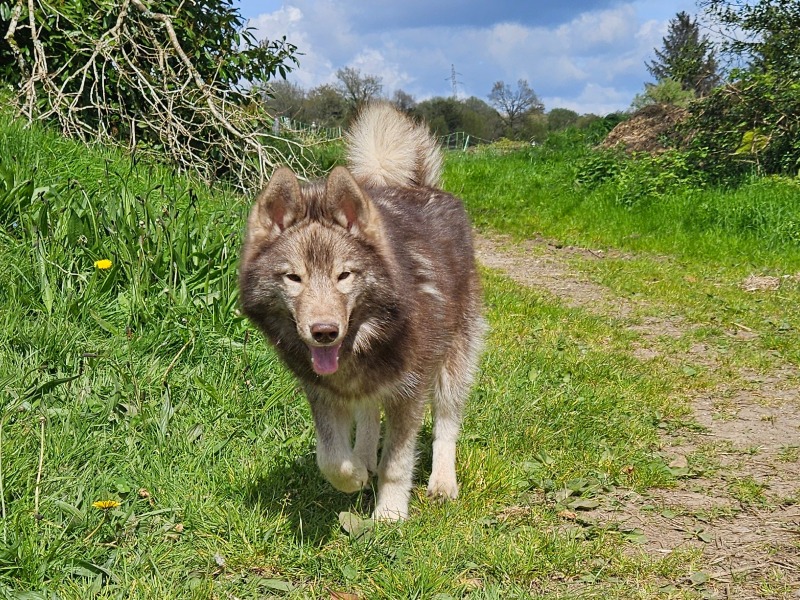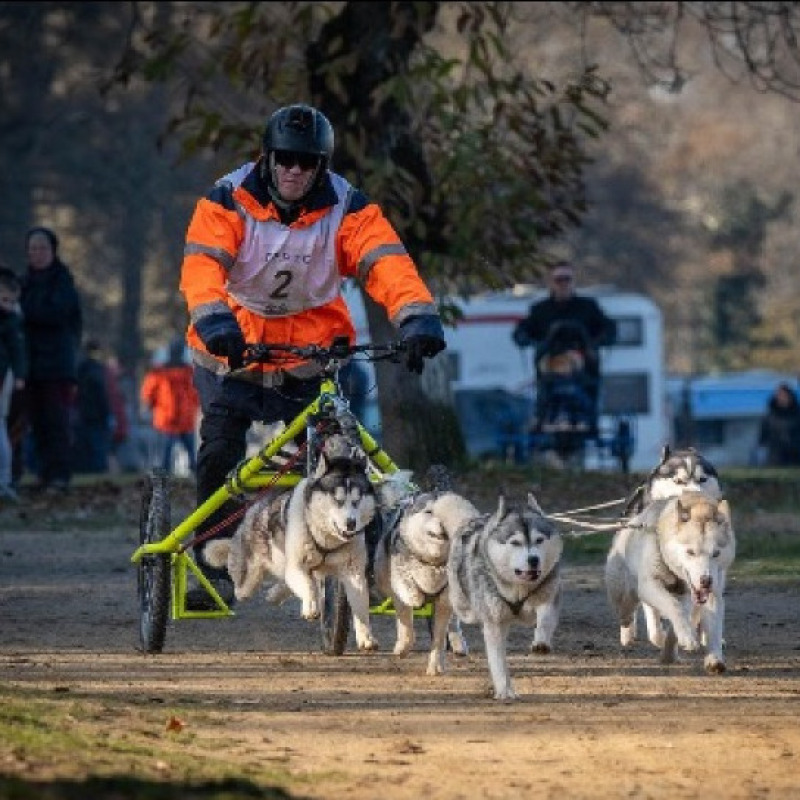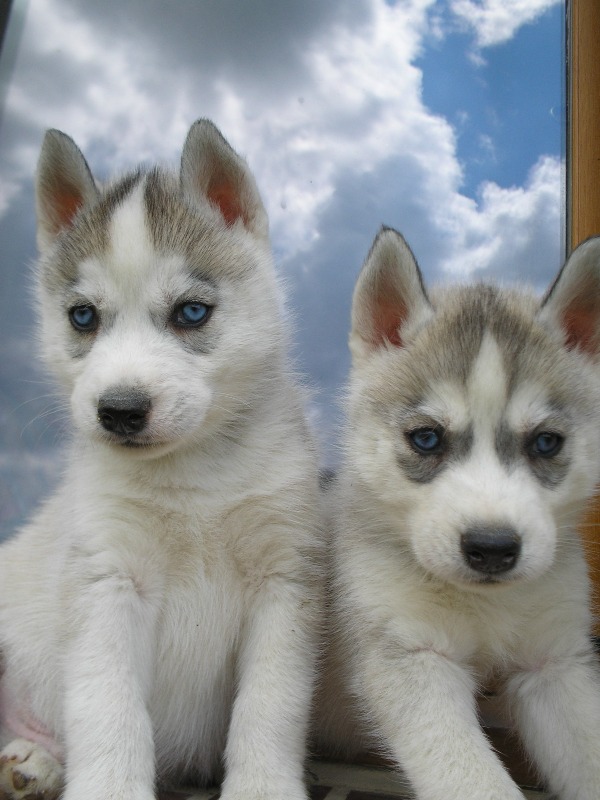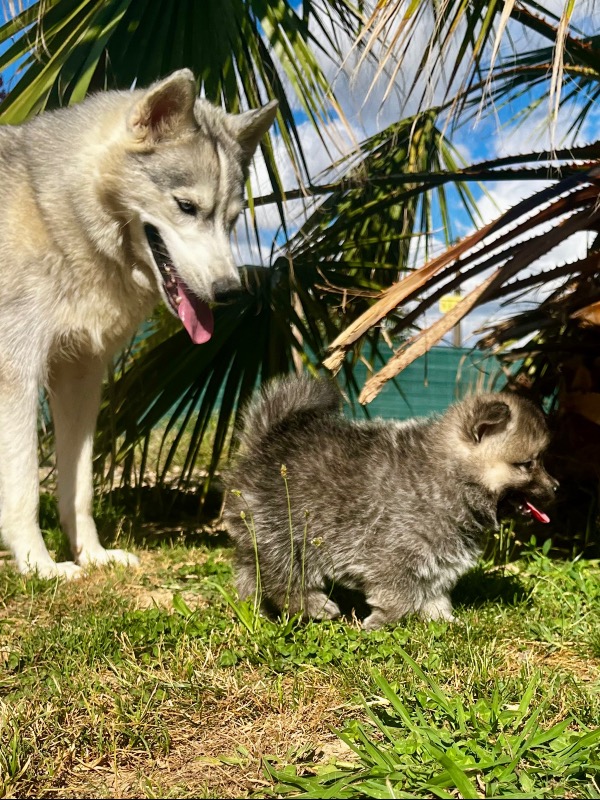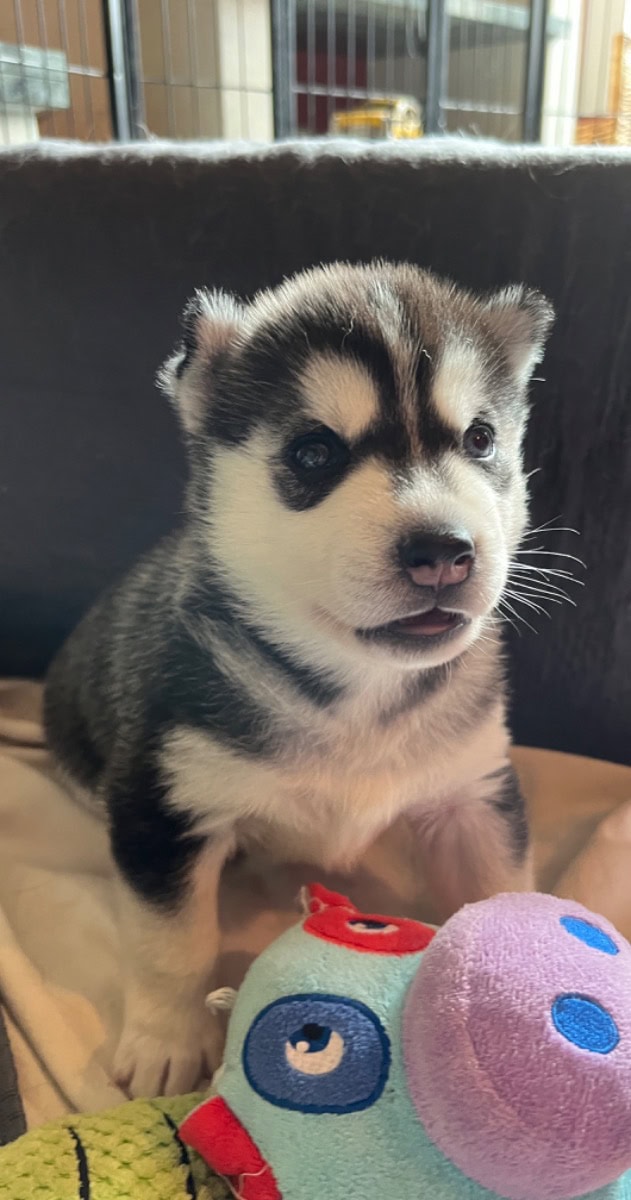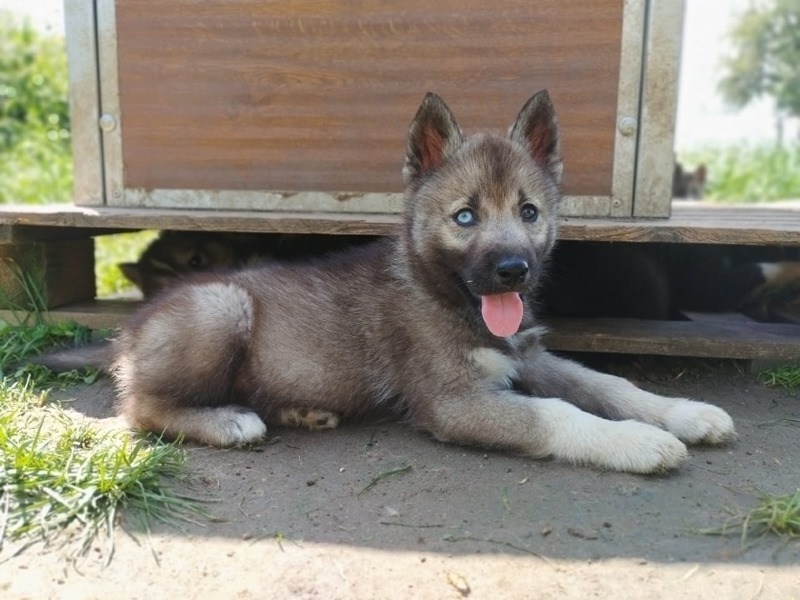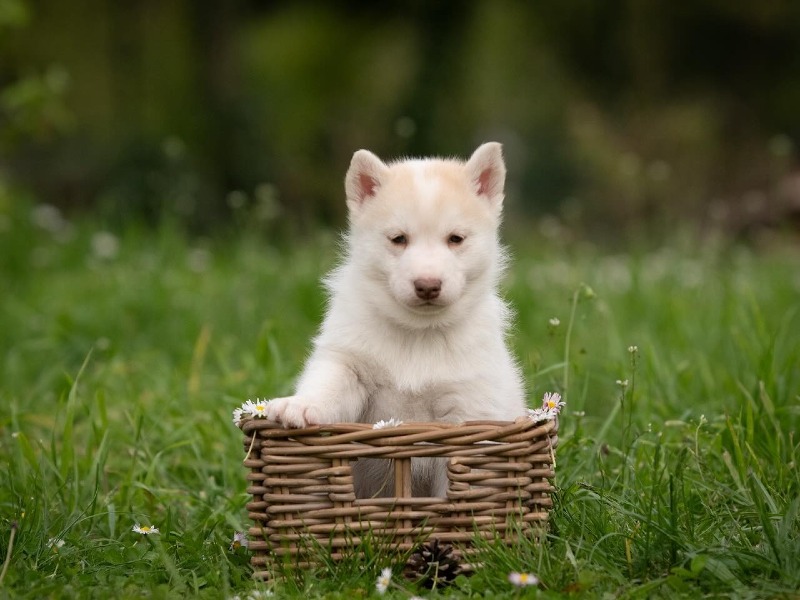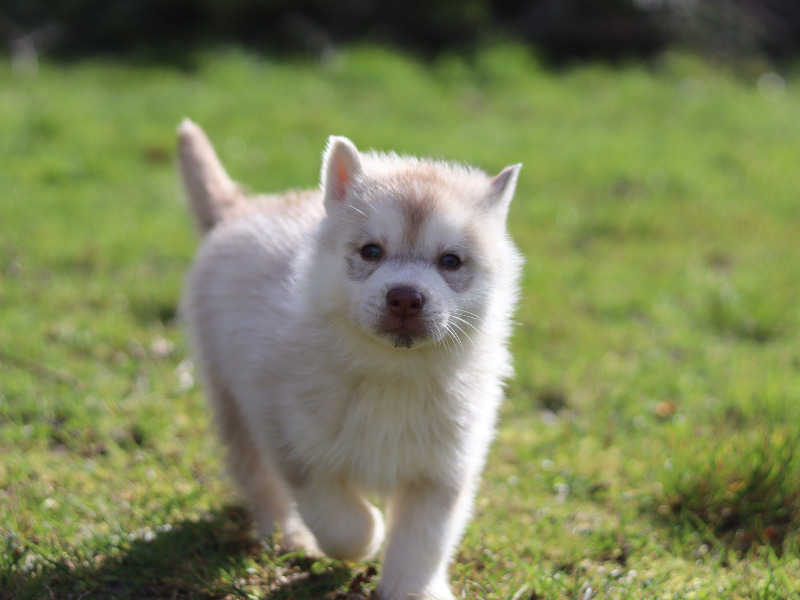Siberian husky
Autres noms : Siberian husky, Siberian husky, Arctic husky
Discover the Siberian Husky, a dog with a joyful temperament and a majestic appearance. Originating from cold regions, it is known for its intelligence, boundless energy, and thick coat. A perfect adventure companion, it combines loyalty and independence.
Awareness of acquiring an animal
Adopting or breeding a dog is a responsibility that must be carefully considered. Dogs are loyal companions that require time, attention, and constant care. Whether for leisure, passion, or professional breeding, it is crucial to understand the specific needs of each breed. Provide them with a loving and stimulating environment, and avoid any impulsive acquisition that could harm their well-being. Be a vigilant and committed owner for a happy and healthy companion.
To learn more about animal welfare, we invite you to consult our FAQ by clicking the button below:
Origins and history
The Siberian Husky finds its origins in the Arctic regions of Siberia, where it was raised by the nomadic Chukchi people. These dogs were essential for transporting goods and pulling sleds, thanks to their endurance, agility, and intelligence. Their role as sled dogs was crucial in extreme environments, where they could cover long distances while enduring freezing temperatures.
In the early 20th century, these dogs were introduced to North America, where they quickly gained popularity due to their distinctive appearance and natural abilities. Breeders began selecting them for specific traits, including their friendly temperament and work ethic. This led to official recognition of the breed by various kennel organizations, solidifying their status as both companion and working dogs.
Today, the Siberian Husky is valued not only for its role as a pet but also for its skills in canine sports such as sledding and carting. The breed embodies a unique blend of strength, liveliness, and sociability, making it a popular choice among dog enthusiasts.
Physical characteristics
The Siberian Husky is a medium-sized dog that impresses with its well-proportioned stature and elegance. Males typically stand between 50 and 60 centimeters at the withers and weigh between 20 and 27 kg, while females are slightly smaller, measuring 45 to 50 centimeters in height and weighing 16 to 23 kg. Its muscular and robust body showcases its endurance, an essential characteristic for sled dogs.
The head of the Siberian Husky is triangular in shape, with a slightly rounded skull and well-developed cheeks. Its eyes, often almond-shaped, can be brown or blue, and some individuals even have one eye of each color. The ears are upright and of medium size, pointed, and positioned wide apart on the skull.
The coat is one of the most striking features of this breed. It is dense, double-layered, and weather-resistant, providing excellent insulation against the cold. Colors vary from black to gray, red, and white, with patterns often characteristic on the face, body, and limbs. This fur requires regular grooming to maintain a clean and healthy appearance. In summary, the Siberian Husky embodies a beauty that is both wild and refined, reflecting its heritage as working animals in extreme conditions.
Character
The Siberian Husky is a working dog with a unique and captivating temperament. Their personality is often described as friendly and sociable. These dogs are very attached to their families and maintain close relationships with household members. They show a great affinity for children and generally get along well with other animals, provided they receive adequate socialization from a young age.
Another notable trait is their boundless energy. Siberian Huskies require a lot of daily exercise to stay healthy and happy. They enjoy outdoor activities such as running, hiking, and sledding. Their endurance is impressive, making them well-suited for active environments where they can expend their energy.
Furthermore, these dogs are characterized by their independence. They can sometimes appear stubborn, which necessitates consistent and patient training. It is crucial to establish a clear hierarchy while maintaining a positive approach. Due to their intelligence, they can get bored easily, which highlights the importance of stimulating their minds through games and challenges.
Finally, their loyalty and affection make Siberian Huskies devoted companions. Their balanced character, combined with their wild beauty, makes them particularly sought-after pets.
Life expectancy
The life expectancy of Siberian Huskies is generally between 12 and 15 years. This duration can vary depending on various factors, including genetics, diet, exercise, and veterinary care. Huskies are often robust dogs, but like all breeds, they can be prone to certain health conditions.
A good diet plays a crucial role in the longevity of a husky. A balanced diet, rich in nutrients, helps maintain their ideal weight and prevent health issues such as obesity. Owners should also ensure they provide enough exercise, as these dogs are naturally active and need to move regularly to stay healthy.
Furthermore, regular visits to a veterinarian allow for monitoring the animal's overall health, early identification of potential issues, and effective treatment. By taking care of their physical and mental well-being, owners can help maximize the life expectancy of their four-legged companion.
Exercise and activity needs
The Siberian Husky is an extremely active and energetic dog breed that requires a significant amount of daily exercise to maintain both physical and mental health. Due to its heritage as a sled dog, it needs about 1 to 2 hours of moderate to intense activity each day. This can include running, brisk walks, and outdoor play.
Activities should be varied to keep the Husky's interest. Canine sports such as agility, skijoring, and canicross are particularly well-suited as they allow for the expression of their natural running instincts. In addition to physical exercise, mental stimulators, such as tracking games or treat-dispensing toys, are also beneficial to prevent boredom, which can lead to destructive behaviors.
Finally, it is essential to recognize that these dogs have a strong need for social interaction, whether with their humans or other animals. Group outings or playtime with other dogs can fulfill this need while allowing them to expend their energy. Ensuring a proper balance between physical exercise and mental stimulation is crucial for the overall well-being of the breed.
Recommended diet
The diet of the Siberian husky must meet its high energy needs, especially due to its physical activity and active lifestyle. It is recommended to choose food rich in protein, sourced from animals such as chicken, beef, or fish. This helps support muscle mass and maintain energy levels.
Carbohydrates also make up an essential part of their diet. It is advisable to prioritize high-quality carbohydrate sources, such as sweet potatoes or brown rice, which provide stable energy without causing blood sugar spikes. Fiber, found in vegetables, should also be included to promote healthy digestion.
Hydration is crucial; therefore, it is important to ensure that huskies always have access to fresh water. Additionally, some owners choose to include dietary supplements, such as omega-3 fatty acids, to support healthy skin and coat. Finally, meal regularity is essential to maintain their metabolism at an optimal level.
Training and obedience
Training a Siberian Husky requires a specific approach due to its independent nature and intelligence. From a young age, it is essential to start training with short and engaging sessions. These dogs respond better to positive methods and reinforcement, so using treats and praise is recommended to promote effective learning.
Socialization is another crucial aspect. It is important to expose the Husky to different environments, people, and other animals from an early age. This will help them develop balanced behaviors and reduce the risks of aggression or shyness in adulthood.
Additionally, it is essential to keep in mind that this breed has a strong hunting instinct and a tendency to follow scents. Therefore, leash walks are a must, as is training for recall. Regular agility exercises or canine sports can also help channel their abundant energy.
Finally, persistence and patience are the keys to success. Huskies can sometimes be stubborn, but with a consistent approach, it is possible to establish a great mutual learning relationship.
Behavior with children
The Siberian Husky is often seen as a friendly and playful dog, making it a beloved companion for families with children. Their boundless energy and sociable nature prompt them to actively engage with kids, creating moments of fun and happiness. Thanks to their curiosity, these dogs easily integrate into family activities, whether it's outdoor games or walks.
However, it is essential to monitor interactions between Huskies and young children. Their behaviors can sometimes be impulsive, and despite their friendliness, they may accidentally bump into a child during intense play. Early training is crucial to teach the dog appropriate behaviors, such as gentleness and respect for the personal space of younger ones.
Additionally, it is important to ensure that children learn to respect the dog. Establishing clear rules regarding interactions, such as avoiding disturbing the dog while it is eating or sleeping, can help prevent accidents. With proper socialization and attentive supervision, Siberian Huskies can become loyal and loving playmates for children, bringing joy and energy to the home.
Compatibility with Other Animals
The Siberian Husky is a dog breed that has a dynamic and social personality, greatly influencing its compatibility with other pets. Generally, these dogs get along well with other dogs, especially if they have been socialized from a young age. Their playful nature and desire for companionship make them good companions for other canines, as long as they have been properly introduced.
However, coexisting with smaller animals like cats or rodents can be problematic. Their hunting instinct is quite strong, which can lead to predatory behavior. If a Husky has not been accustomed to living with smaller animals, it is likely that it will see them as prey. This requires close supervision and, if possible, early training to mitigate these instincts.
Finally, the living environment can also play a crucial role. A spacious environment allows the Husky to expend energy and socialize more easily, thereby reducing competitive or aggressive behaviors towards other animals. Therefore, proper socialization, adequate training, and a conducive environment are key factors in ensuring harmonious coexistence between a Siberian Husky and other pets.
Grooming needs
Grooming and maintaining a Siberian Husky requires special attention due to their thick, double coat. This dog has a dense undercoat that provides excellent insulation against the cold, but it also involves regular shedding periods. Generally, these dogs shed their fur twice a year, in spring and autumn. During these times, daily brushing is recommended to prevent the accumulation of dead hair and reduce the risk of tangles.
Outside of shedding periods, weekly brushing is sufficient. This helps maintain the health of their coat and control odors. It is important to use an appropriate brush, preferably a bristle brush or a dematting comb. Baths are not needed frequently, as excessive washing can strip the natural oils from their skin. Generally, a bath every few months is enough, or if the dog is excessively dirty.
Caring for the ears, teeth, and nails is also essential. Ears should be checked regularly to avoid infections. As for their teeth, regular brushing helps prevent dental problems. Lastly, nails should be trimmed regularly to avoid discomfort and injuries. A disciplined grooming routine ensures a healthy and happy Siberian Husky.
Health
The Siberian Husky is a breed appreciated for its majestic appearance and friendly temperament. However, like any dog, it is subject to certain health issues that deserve special attention.
First of all, Huskies are generally healthy, but they can suffer from hereditary diseases. Among the common conditions, hip dysplasia and elbow dysplasia are frequent. These joint problems can cause pain and reduced mobility, especially affecting older dogs or those with excess weight.
Next, cataracts are another concerning condition. Although often related to age, some Huskies may develop this issue earlier due to genetic factors. Regular check-ups with the veterinarian are essential to detect these eye problems at an early stage.
Finally, it is important to pay attention to their diet and exercise. Huskies are active dogs that need plenty of exercise to stay healthy. Obesity can worsen joint problems and lead to other complications. A balanced diet and an active lifestyle are therefore crucial for their overall well-being.
Environment and habitat
The Siberian Husky is a dog breed originating from the Arctic regions of Siberia, where it was bred by nomadic peoples to pull sleds and guard reindeer. This origin explains its exceptional adaptation to cold climates. Its dense coat, made up of an insulating undercoat and a waterproof outer fur, allows it to survive in extremely low temperatures.
Regarding its habitat, the Siberian Husky prefers cool or temperate environments. Although it can acclimate to higher temperatures, it can suffer from the heat, which is why it's important to keep it in sufficiently cool spaces. This dog is particularly active and requires a large space to expend its energy, ideally a garden or a fenced area.
Social and intelligent, the Husky thrives in the company of its family but needs regular physical activities to avoid boredom and destructive behavior. Daily walks or canine activities such as sledding or canicross are essential for its well-being.
Name ideas
Choosing a name for a dog is an important task that should take several criteria into account. First of all, it is essential to choose a name that is easy to pronounce and remember, both for the owner and the dog. Short names, typically one to three syllables long, are often more effective as they allow for quick recognition. Additionally, a name that contains clear and distinct sounds will facilitate the animal's understanding.
Next, it is wise to opt for a name that reflects the personality, appearance, or breed origin. The Siberian husky is known for its endurance, independent spirit, and beautiful coat. A name inspired by these characteristics can strengthen the bond between the owner and their companion.
Here are some suggestions that could suit a Siberian husky: Blizzard, Luna, Koda, Snow, Yukon, Aurora, Sable, Nika, Shadow, Kira, Juno, Tundra, Fanny, Kimi, and Astro. These choices evoke elements of nature, Nordic landscapes, or character traits, thus contributing to affirming the unique identity of this exceptional dog.
Average purchase price
The acquisition of a Siberian husky involves several factors that influence the purchase price. Generally, prices can vary significantly depending on the country, the reputation of the breeder, and the pedigree of the animal. On average, the cost for a puppy from a reputable breeder ranges between 800 and 2000 euros. This cost often reflects the importance of the care provided by the breeder, including socialization and initial vaccinations.
It is crucial to choose a serious breeder who practices responsible breeding, as this can impact the future health and behavior of the animal. Higher prices may also include health tests to ensure that the dogs are raised without genetic diseases. Puppies from champion lines can cost even more, often starting at 2500 euros.
Finally, it is important not to overlook the additional costs associated with caring for a dog. This includes food, veterinary care, equipment, and training, which can add up and represent a significant budget over the long term.
Expenses
Owning a Siberian Husky requires careful consideration of monthly expenses. First of all, food is one of the most significant expenses. On average, a Husky consumes between 300 and 700 grams of kibble per day, depending on its age and activity level. This can amount to between 50 and 100 euros per month.
Next, it is essential to take veterinary care into account. Annual visits for vaccinations, deworming, and health check-ups can cost around 200 euros per year, which is about 17 euros per month. However, it is advisable to budget for additional amounts for emergencies, which can bring this total to about 30 euros per month.
Accessories such as toys, collars, leashes, and beds should also be considered. For these items, a budget of approximately 10 to 20 euros per month is reasonable. Lastly, it's wise to consider the costs associated with pet sitting or walks if you are frequently absent. This can add around 100 euros per month.
In summary, for a Siberian Husky, it is prudent to budget between 200 and 300 euros per month, depending on food choices and the care options selected. This estimate helps ensure the well-being of your four-legged companion.
Destination and usage
The Siberian Husky is a dog breed that captivates many owners with its lively personality and attractive appearance. As a pet, this type of dog is distinguished by its high energy and need for activity. Families that choose a Husky can expect a dynamic companion, perfect for outdoor activities such as hiking, jogging, and playing in the snow. Its natural curiosity and enthusiasm make it an excellent partner for sports activities.
Additionally, the Siberian Husky is often appreciated for its sociable and friendly temperament. They generally get along well with children and can coexist harmoniously with other pets. Their affectionate and protective nature makes them loyal companions, creating strong bonds with their owners. However, it is important to provide them with proper training and early socialization to prevent any undesirable behaviors.
In summary, the Siberian Husky, as a pet, is a captivating choice for people who lead an active lifestyle and seek a faithful friend. Their need for physical activity and interaction with humans underscores the importance of fully integrating them into family life.
Legislation and regulation
The legislation and regulations regarding Siberian huskies vary significantly from country to country. In some countries, these dogs are seen as popular pets, often appreciated for their attractive appearance and friendly nature. The regulations concerning their breeding and care mainly focus on general animal welfare requirements, such as vaccination, sterilization, and living conditions.
However, in other regions, specific laws may exist due to potentially problematic behaviors of certain breeds. Huskies have a strong hunting instinct and can be difficult to train. Consequently, where restrictions may be imposed, they often include strict requirements for training and socialization. These laws can include mandatory registration and regulations on leash use in public spaces.
Furthermore, some municipalities enforce restrictions on the ownership of dogs deemed dangerous, which can indirectly affect huskies. Therefore, owners must be aware of local laws to avoid legal complications. In summary, the regulations vary greatly, and it is crucial for prospective owners to inform themselves about the applicable legislation in their area.
Official recognition
The Siberian Husky is a breed of dog of Nordic origin, recognized for its many qualities, including strength, endurance, and friendly temperament. In many countries, official canine organizations acknowledge this breed. For example, in the United States, the American Kennel Club has established precise breed standards, which frame selection and dog shows. This recognition ensures a certain genetic quality and respect for the physical and behavioral traits specific to the breed.
In Europe, the Fédération Cynologique Internationale also recognizes the Siberian Husky. This means that there are breed standards that must be adhered to during breeding. Breeders must follow these standards to maintain the health and well-being of the dogs. In other countries, such as Canada and Australia, specific clubs support the breed, facilitating the exchange of information and organizing competitions.
Finally, the growing popularity of this breed worldwide has led to better awareness of its specific needs, particularly regarding exercise and socialization. Thus, this official recognition proves crucial for preserving the integrity of the breed and promoting responsible breeding.
Pedigrees
To obtain a pedigree for the Siberian Husky breed, it is essential to turn to recognized dog registries. One of the main international organizations is the Fédération Cynologique Internationale (FCI), which establishes breed standards and registers pedigrees through its members. Breeders who are members of the FCI can provide official documents certifying the lineage of the animals, which is crucial for ensuring the purity of the breed.
In France, the Livre des Origines Français (LOF) is the association that manages the registration of Siberian Huskies. Breeders registered with the LOF can provide pedigrees that comply with FCI requirements. These documents allow for tracking the lineage of the dogs and provide a clear understanding of their genetic backgrounds.
Outside of France, other national clubs such as the Siberian Husky Club of America or the Canadian Kennel Club play a similar role in the registration and certification of Siberian Huskies. Each country may have its own requirements, but these organizations all work to maintain breed standards and encourage best breeding practices. Therefore, for any owner or breeder wishing to obtain a pedigree, it is essential to choose a recognized club or registry and ensure that the breeding practices comply with established standards.
Prohibitions
Certain regulations regarding dog breeds, particularly the Siberian Husky, vary significantly from one country to another. In some countries, these dogs are welcomed without restrictions, valued for their friendly nature and endurance. They are often chosen by families and outdoor enthusiasts, especially in colder regions.
However, other countries impose restrictions due to concerns related to aggression or behavior. In some cases, local laws regulate the ownership of dogs considered potentially dangerous. While the Siberian Husky is generally viewed as a sociable dog, incidents of bad behavior can raise concerns among authorities.
Additionally, some municipalities establish specific regulations regarding the living conditions and exercise of this breed. Given their need for physical activity and socialization, restrictions may be put in place to prevent situations of neglect or abandonment.
Finally, potential owners should always inquire about the legislation in force in their area to ensure responsible and compliant ownership.
Breeders of Siberian husky
Want to see more breeders of Siberian husky?
Check out the page of our directory listing all breeders of Siberian huskyClassified Ads of Siberian husky
Breed clubs of siberian husky
No of siberian husky breed clubs are currently registered on Preeders.
If you would like to highlight your breed club, sign up for free now and be the first to appear on this page.

